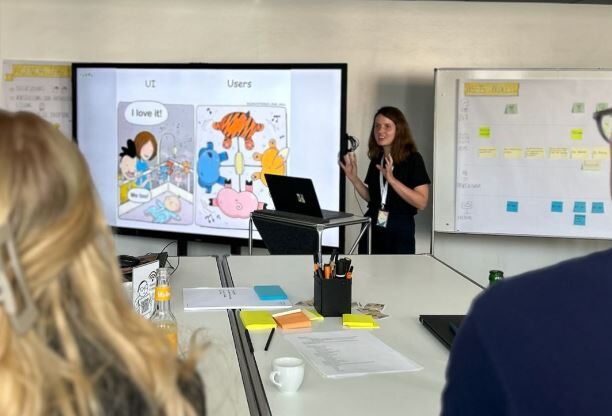
5 key factors for the success of a BTP hackathon
Deep dive into existing processes? Get to know new technologies? Or simply get to know your team in a completely new constellation? A lot is possible with a hackathon. And to ensure that as many companies as possible can benefit from the power of a hackathon, our BTP Squad offers its support. This was the case, for example, with our last SAP BTP Hackathon with the Federal Office of Posts and Telecommunications (BAnst PT) and SAP. In a relaxed, informal and playful atmosphere, the teams were supposed to get to know the technology stack on SAP BTP better before the upcoming project. But what makes such a hackathon successful? Larissa Haas, Senior Data Scientist at sovanta, summarised her 5 success factors for us:
1. The topic should not be too complex
The topic itself is not that important. However, it is especially practical if the topic is known to many people and can be easily understood while implementing the use case. If there is no specific topic for an upcoming hackathon, you can of course let the participants decide spontaneously what they want to implement. It is a good idea to limit the context somewhat and provide a framework – for example, asking the teams to develop something for their daily work.
2. Participants need to have the right mindset
Whether you are technically experienced or a complete beginner – everyone can take part in a hackathon. You always work and learn in a team, without being left alone anywhere. In the end, everyone benefits. Of course, the basic requirement is that you are open to learn new things, to fail, to try things out and not to get frustrated too quickly. If you reject new changes right from the start, a hackathon is definitely not the right thing for you.
3. Small teams with a good mix of skills
In our experience, three to five teams with a maximum of five people each is a good setup for a hackathon. Depending on the topic, this is a good way to distribute the tasks, but also to keep track of each other. The teams can be formed beforehand or at random. It is important that the competences are evenly distributed in the teams, i.e. if some people are very technically inclined, they should not all work in one team.
4. The right expectation
The result of a hackathon is definitely not a productive use case. Even the initial approaches will probably not be usable in the same way. But a lot is learned in a hackathon, the teams will fail and have to build on that. This experience can then be used in further projects to make better decisions or to rebuild the case “cleanly”.
5. Find supporters for the hackathon
It definitely makes sense to secure the support of management or decision-makers for a hackathon in advance. On the one hand, it shows the participants that their work and learning is valued, and on the other hand, it shows management how much enthusiasm and group dynamics can arise when employees are given freedom and a change of context. It is also important that management has the right expectations of a hackathon, so that there are not suddenly tough requirements that have to be met in the short time available.
Would you also like to organize a hackathon with your team?
No problem, just contact us. We’ll provide you with the right space and everything you need to create the “hacky vibe”. Our experts will provide infusions on the desired topics and will be on site to answer any questions, depending on the topic and technology.




